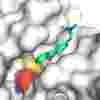Thanks to the kindness and generosity of our supporters, we have been starting cancer cures from day one. In the 1980s and early 1990s, we funded several projects led by Professor Stephen Bown, which allowed him to propel a laser therapy called photodynamic therapy from the lab into the clinic. Photodynamic therapy is now available as a treatment option for patients with some types of cancer. And it can even lead to a cure for some people if used early enough.
We are currently testing our technology in India because mouth cancer is highly prevalent there and PDT may be able to offer a cure for early cases. The LED light source runs on a couple of AA batteries so there’s no reliance on electricity. We are trying to bring a relatively cheap curative option to an area of the world that can’t normally get access.

Photodynamic Therapy (PDT) involves the use of a drug that is triggered when activated by light. For some types of early skin cancer, the drug is applied as a cream which can be activated by a range of sources of red light. For internal cancers, the light source is usually a laser and the drug is given by mouth or injection - it accumulates in the cancerous area and the laser is used to shine a light which activates the drug and causes local tissue destruction.
With a background in physics before he went to medical school, Professor Stephen Bown's research career has focused on using lasers to treat many different diseases, particularly cancer. He is a pioneer in his field and was a key person involved in the establishment of the National Medical Laser Centre at University College London in 1984.
In the late 70s and early 80s, Stephen was looking at how to use endoscopes to direct laser beams to stop stomach ulcers bleeding. This led to the use of lasers with endoscopes to relieve obstructions to major organs such as the gullet, major airways and bowels, caused by advanced cancers.
Professor Bown and his team treated the first oesophageal cancer patient in 1981 and these techniques are now used in routine clinical practice.

In the 1980s and early 1990s, Professor Bown was awarded several project grants from Worldwide Cancer Research to further study this experimental therapy, allowing him to propel PDT from the lab into the clinic.
PDT has found its place in today’s treatment arsenal as a therapy for early stage cancer and is approved by the NHS for use in oesophageal, skin and oral cancers. It’s also a highly effective treatment for conditions such as Bowen’s disease, where some very early cancer cells have emerged on the outermost layer of the skin.
And Professor Bown's research into PDT has continued throughout his career. His latest venture has been to team up with the US government and research groups in Boston and in India to develop technology that uses LED lights instead of a laser to activate the PDT drug.
These drugs that accumulate in cancer cells and react to light can also be used to visualise early cancers in the mouth using a mobile phone, another valuable advance for countries with limited resources.
By becoming a Curestarter, you can help us continue to support more bright ideas like Professor Bown's - allowing us to potentially uncover new knowledge about cancer that could lead to lifesaving new ways to prevent, diagnose, and treat cancer.

Donate now & become a Curestarter
Be part of a united effort to stop lives being cut short by cancer.



